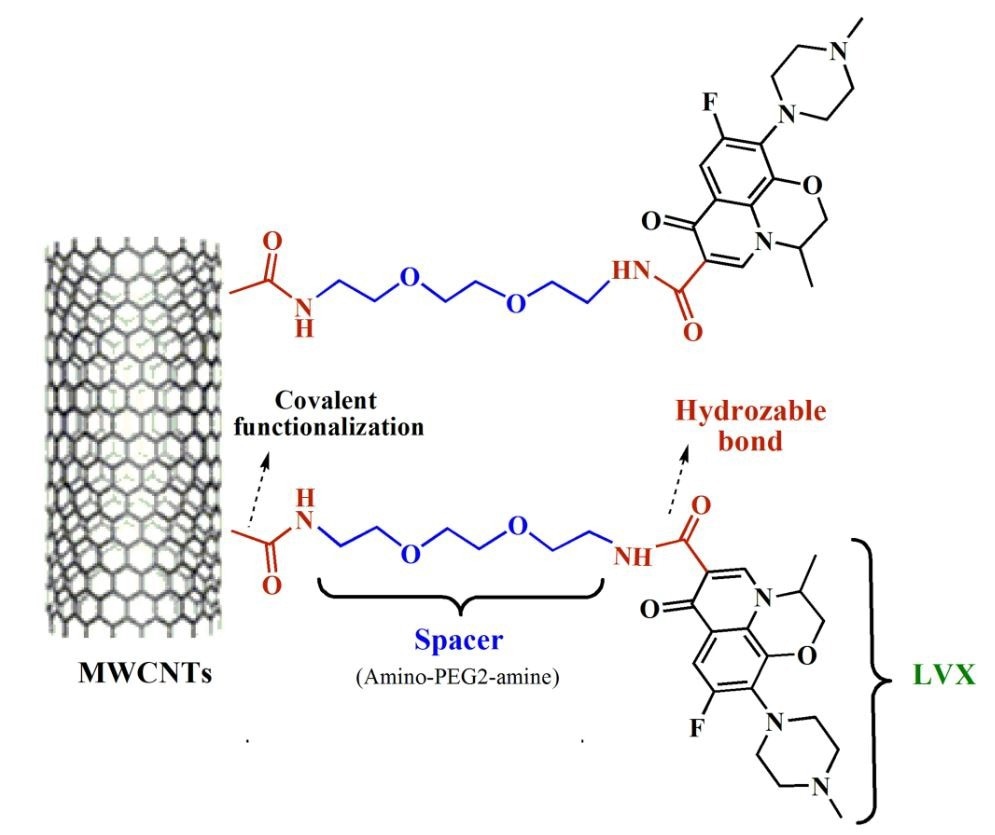Carbon nanotubes (CNTs) are promising nano-carriers in biomedical applications. In an article recently published in the journal Scientific Reports, the researchers reported a nano-antibiotic by conjugating levofloxacin with multi-walled CNTs (MWCNT-LVX), wherein the drug was grafted with surface-modified CNT to achieve a nano-drug that is safe, effective, and fast-acting.

Study: Robust antibacterial activity of functionalized carbon nanotube- levofloxacine conjugate based on in vitro and in vivo studies. Image Credit: Hassani, M., et al (2022)
Nanomaterials as Antibacterial Drug Delivery Systems
Enhancing the antibacterial agent’s efficacy by employing combination therapy or drug delivery systems based on nanotechnology can expedite the drug development process. Recently, nanomaterials have been extensively applied as nano-carriers for antibacterial drug delivery, especially to treat resistant infections.
The high surface area to volume ratios, hollow structure, ideal compatibility, and remarkable penetration through cell membrane are a few favorable properties of CNTs for their application as nano-carriers. Nevertheless, the poor dispersibility, toxicity, and hydrophobic nature of MWCNTs limit their biomedical applications. To this end, surface modification of MWCNTs using various functionalization approaches can enhance their dispersity and biocompatibility under physiological conditions.
MWCNT-LVX
In the present study, the researchers synthesized a new nano-antibiotic, MWCNT-LVX, by grafting the drug covalently with surface-modified CNTs to achieve a safe, effective, and fast-acting nano-drug. They employed an ultraviolet-visible (UV-vis) spectrometer to evaluate the drug-loading and release profiles at different pH levels.
The synthesized MWCNT-LVX was characterized using a scanning electron microscope (SEM), transmission electron microscope (TEM), and Brunauer–Emmett–Teller analysis. The nano-antibiotic showed better in vitro antibacterial activity against Staphylococcus aureus than Pseudomonas aeruginosa.
The novel nano-drug exhibited high drug loading capacity and pH-sensitive release profile, thus exhibiting more potent bactericidal activity against Staphylococcus aureus infection in mouse model than pure LVX. Based on the obtained results, the researchers revealed that the conjugation of the drug with surface-modified MWCNTs enhanced the antibacterial properties of the drug.
Thus nano-antibiotics have great potential for industrialization for their nontoxicity, proper drug loading and release, simple synthetic route, and strong antimicrobial activity. Moreover, owing to their unique physicochemical properties, MWCNTs can serve as good drug delivery systems with controlled release ability. Their ease of penetration through biological membranes can enhance the drug delivery even at low doses, which further helps in reducing the side effects.
Research Findings
The Fourier transform infrared (FTIR) spectra of MWCNT-COOH showed a strong peak at 1629-centimeter inverse, corresponding to stretching vibrations of carbonyl (C=O), whose presence also confirms the oxidation of CNTs. The IR bands at 1695 and 779-centimeter inverse corroborated the stretching vibrations of MWCNT-acyl chloride (COCl), confirming the successful chlorination of MWCNT-COOH. Further, the amidation reaction on MWCNT-COCl showed the carbonyl stretching vibrations in the MWCNT-NH2 at 1625 and 1679-centimeter inverse, confirming the elimination of the acyl chloride group.
In the present study, the pH-controlled delivery of LVX was possible using MWCNT-LVX at pH values of 5.5, 7.4, and 10.5. They observed that at pH 5.5 complete and sustained release of the drug was achieved by MWCNT-LVX by day five. Approximately 25 to 50% of LVX was released between 6 and 24 hours in acid media. At pH 7.4, the LVX release was in a slow and controlled manner after day four.
LVX was attached to the surface-modified MWCNTs via hydrogen bonds, which were weakened at a pH of 5.5, triggering the release of LVX at a higher amount. Moreover, the amide bonds that existed between LVX and MWCNT-NH2 were steadily hydrolyzed in acidic media, which indicates the drug was released over an extended period.
The above results confirm that a single dose of MWCNTLVX can maintain a high local LVX concentration for several days, avoiding the need to administer multiple doses and the consequent side effects. The common agglomeration problem in CNTs was overcome by the surface modification of MWCNTs, leading to easy dispersion in biological media.
The field emission SEM images showed the nano-antibiotic’s groovy and rough surface; this uneven surface was due to the distribution of the drug in MWCNT’s surface via covalent and non-covalent attachments. Moreover, TEM analyses with high magnification confirmed the dispersion of MWNTs. TEM images revealed the interlocking of MWCNT-COOH with each other. However, a layer of the drug was observed after loading the MWCNT-NH2 with the respective drug.
Conclusion
In conclusion, the researchers successfully synthesized an antibacterial nano-conjugate by covalently grafting the drug on surface-modified MWCNTs. The biocompatibility and aqueous dispersity of the synthesized nano-antibiotic was enhanced by the amino-polyethyleneglycol (PEG)2-amine (NH2) linker that existed between the drug and MWCNTs. The observation drawn on the high drug loading capacity of MWCNTs and the pH-sensitive release of the drug affirmed the efficiency of MWCNT-NH2.
The topical administration of the nano-antibiotics solution confirmed the potent antibacterial activity on Staphylococcus aureus-infected burn wounds. Further, the as-prepared new nano-antibiotic enhanced the biocompatibility without exhibiting toxicity, which confirms its efficacy in treating the infection caused by Staphylococcus aureus.
Reference
Hassani, M., Tahghighi, A., Rohani, M., Hekmati, M., Ahmadian, M., & Ahmadvand, H. (2022). Robust antibacterial activity of functionalized carbon nanotube-levofloxacine conjugate based on in vitro and in vivo studies. Scientific Reports. https://www.nature.com/articles/s41598-022-14206-w
Disclaimer: The views expressed here are those of the author expressed in their private capacity and do not necessarily represent the views of AZoM.com Limited T/A AZoNetwork the owner and operator of this website. This disclaimer forms part of the Terms and conditions of use of this website.